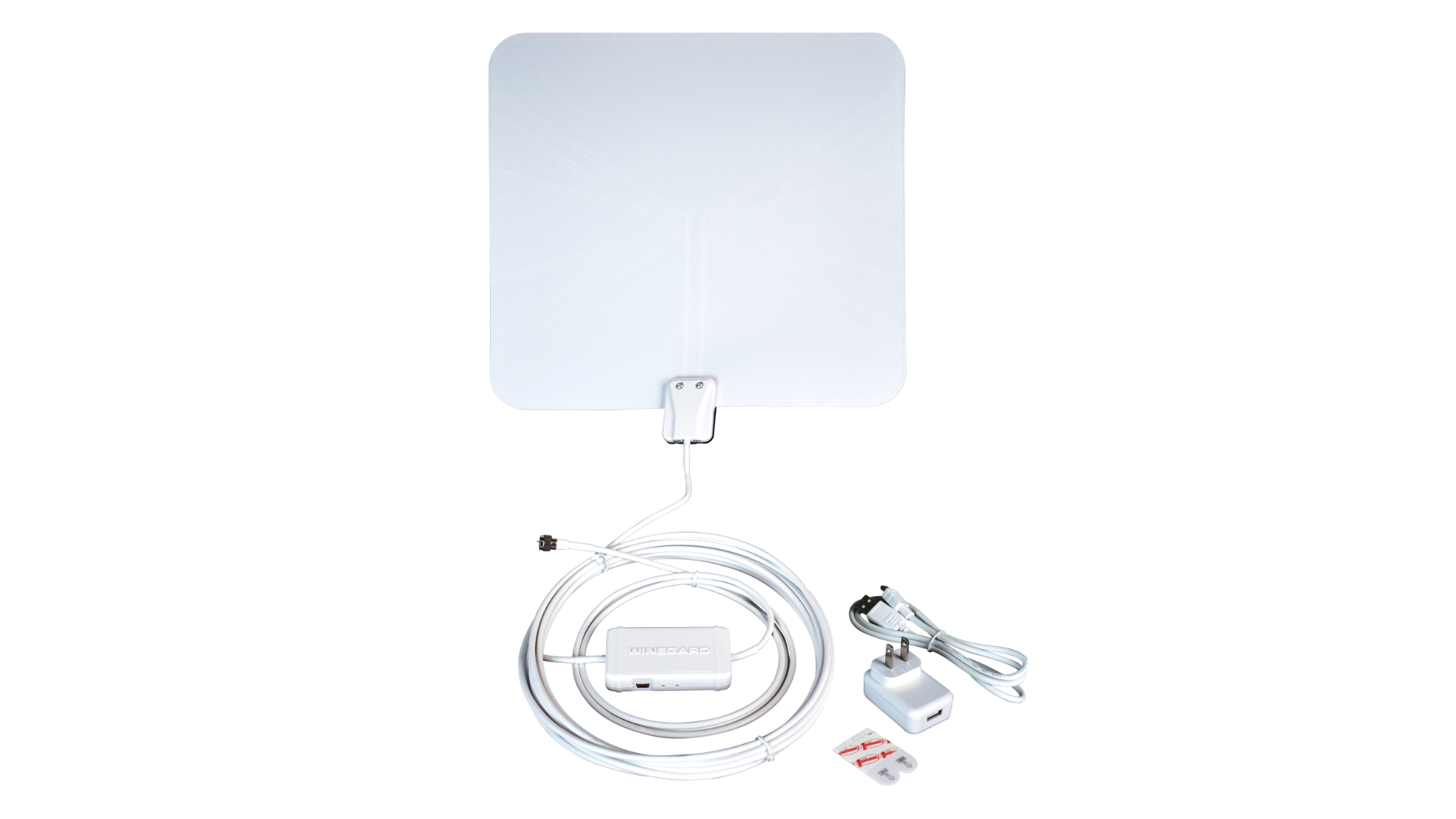TechRadar Verdict
With its ability to be easily hidden, Winegard’s FlatWave Amped Pro is a good choice for viewers who don’t want to see their antenna while reaping its benefits. In this case, that will mean good reception from stations up to 60 miles away, and Winegard’s app-based setup lets you optimize antenna positioning prior to final installation.
Pros
- +
Good range
- +
Perfectly flat membrane design minimizes visual impact
- +
Clever and effective app aids setup
Cons
- -
Needs to be perfectly flat for best performance
- -
Amplifier is mounted down the cable
- -
Less costly but bulkier options offer similar performance
Why you can trust TechRadar
30-second review
Winegard’s FlatWave Amped Pro TH-3000 antenna offers good performance, and uses an effective app for initial setup that shows you real-world reception potential prior to installation.
The TH-3000’s fully flat, zero-footprint, on-window/on-wall design will appeal to the decor-conscious, and it can be relied upon to pull in digital TV stations from as far off as 60 miles. You can find antennas offering similar performance for less, but they are likely to be bulkier and less easily hidden from sight.
Design
The TH-3000 is a perfectly flat, flexible membrane – matte white on one side, matte black on the other to suit decor and location – that’s only about a half-millimeter thick. It’s meant to be mounted on a window or wall with the supplied adhesive tabs (though the small fixture where the down-lead connects is a good deal thicker). A signal amplifier occupying a pod about the size of a jumbo pack of gum is located about two-thirds of the way down the 18.5-foot lead, which is an adequate length for most setups.
The amp module features a blue LED that signals power-on and flashes when pairing with the app. It also has a mini-USB port to acquire power, either from a USB port in the TV or from the small plug-in charger supplied with the antenna.
To set up the Winegard you first download the “Connected” app (iOS/Android) via a QR code on the amp module. The app then walks you through the siting process, showing the number of strong, moderate, and weak stations you can expect. It can also show a map pinpointing these relative to your location – a potentially helpful aid. (Most antenna-makers’ websites, as well as the FCC’s, provide similar maps once you enter your location.)
Each scan by the app takes 10 to 15 seconds, so it’s easy to try various locations for the antenna panel to optimize reception. You can do the same with any antenna via consecutive channel-scans by the TV, but Winegard’s app is a decidedly faster and more convenient solution.
Once you’ve identified the best location, you simply stick the membrane to the window or wall, route and connect the down-lead, and then run a channel-scan on the TV. Two items for attention: First, and unsurprisingly, a window will usually provide better reception than a wall (though construction variabilities are vast); second, I found that the antenna clearly worked best when it was perfectly flat, so if your window has divided lights or other encumbrances, performance may be reduced.
Sign up for breaking news, reviews, opinion, top tech deals, and more.

Performance
Winegard claims a 60-mile range for the FlatWave Amped Pro, which was fairly in line with my results. My semi-rural, hilltop test location enjoys a good elevation almost 360-degree line-of-sight to transmitters ranging from about 15 to about 70 miles, distributed in all directions. With the TH-3000 panel mounted in a south-facing window, my Sony set tuned nine main carriers for about 33 total stations (digital sub-channels), the most distant being a strong signal a bit more than 70 miles distant and located almost due south.
One carrier was borderline, coming in clearly when weather conditions were ideal but blocking and pixelating at other times. While Winegard specs the FlatWave Amped Pro as multidirectional, like virtually all similar indoor designs some directionality must be expected: one medium-power carrier to the east of my test location only came in when the panel was relocated to an east window, where it lost several of the most distant, more southerly signals.
Other, larger indoor antennas have performed a bit better at the same location – though some day-to-day atmospheric variance must be factored in. And to provide some perspective, my home’s attic-mounted rooftop-type antenna tunes a total of 15 or 16 carriers, and up to 70 total stations.
I’m always careful to repeat in reviews that every location will be very different, and the most important variable will always be elevation. So like every other antenna the Winegard should be sited as high as possible.
Should you buy the Winegard Flatwave Amped Pro?

Buy it if...
You live in an urban location or a suburban fringe one
With an ability to pull in signals up to 60 miles, this Winegard should be all the antenna you need.
You don’t want to see an antenna in your room
The FlatWave Amped Pro was designed so that it can be easily hidden from sight.
Don't buy it if...
You can’t install an antenna fairly high up in the room
The FlatWave Amped Pro performs best when perfectly flat (a window installation is best).
You need to pull in stations from a longer distance than 60-70 miles
If you’re living in a rural or semi-rural area that’s far from broadcast TV stations, you’ll do better with a higher-mounted, bulkier indoor antenna, or an outdoor design.
- Ready to pick up a new TV? Don't miss our guide to the best TVs of 2022
Daniel Kumin has written about video, audio, and music technologies for more than three decades, for numerous major magazines and web destinations, and consults in the AV and other industries. He was originally trained as a composer, in case anyone wants to commission a string quartet.
